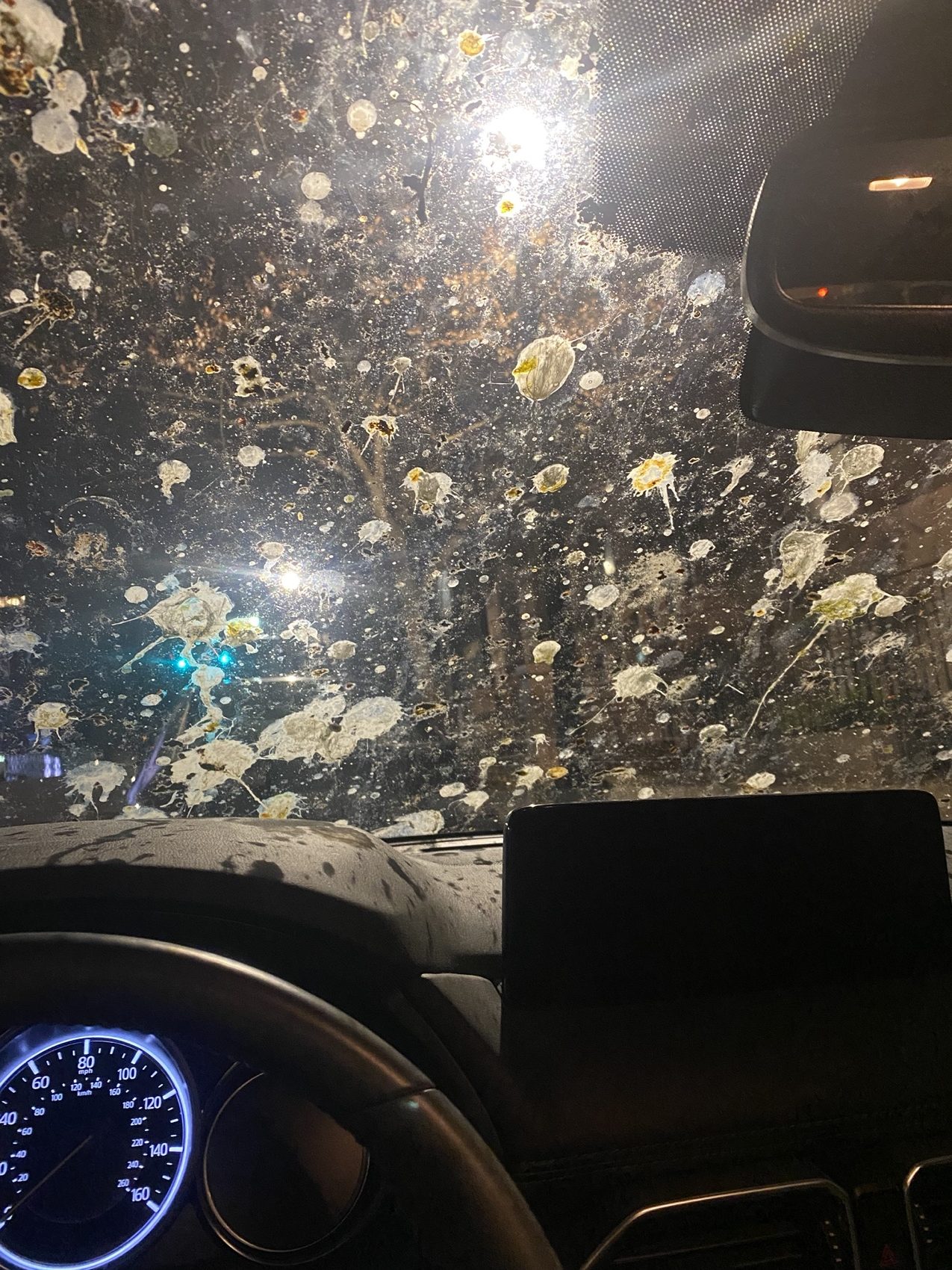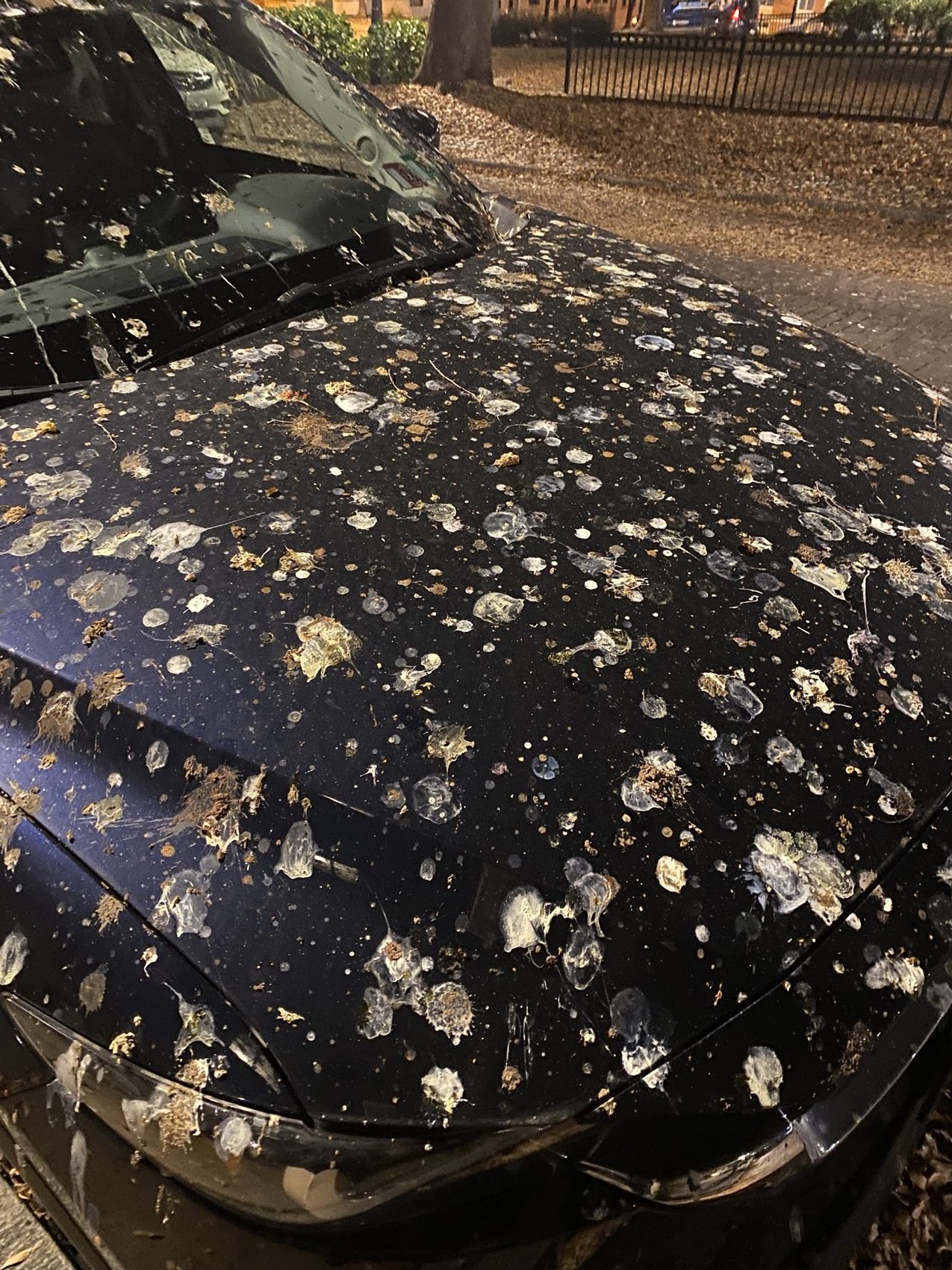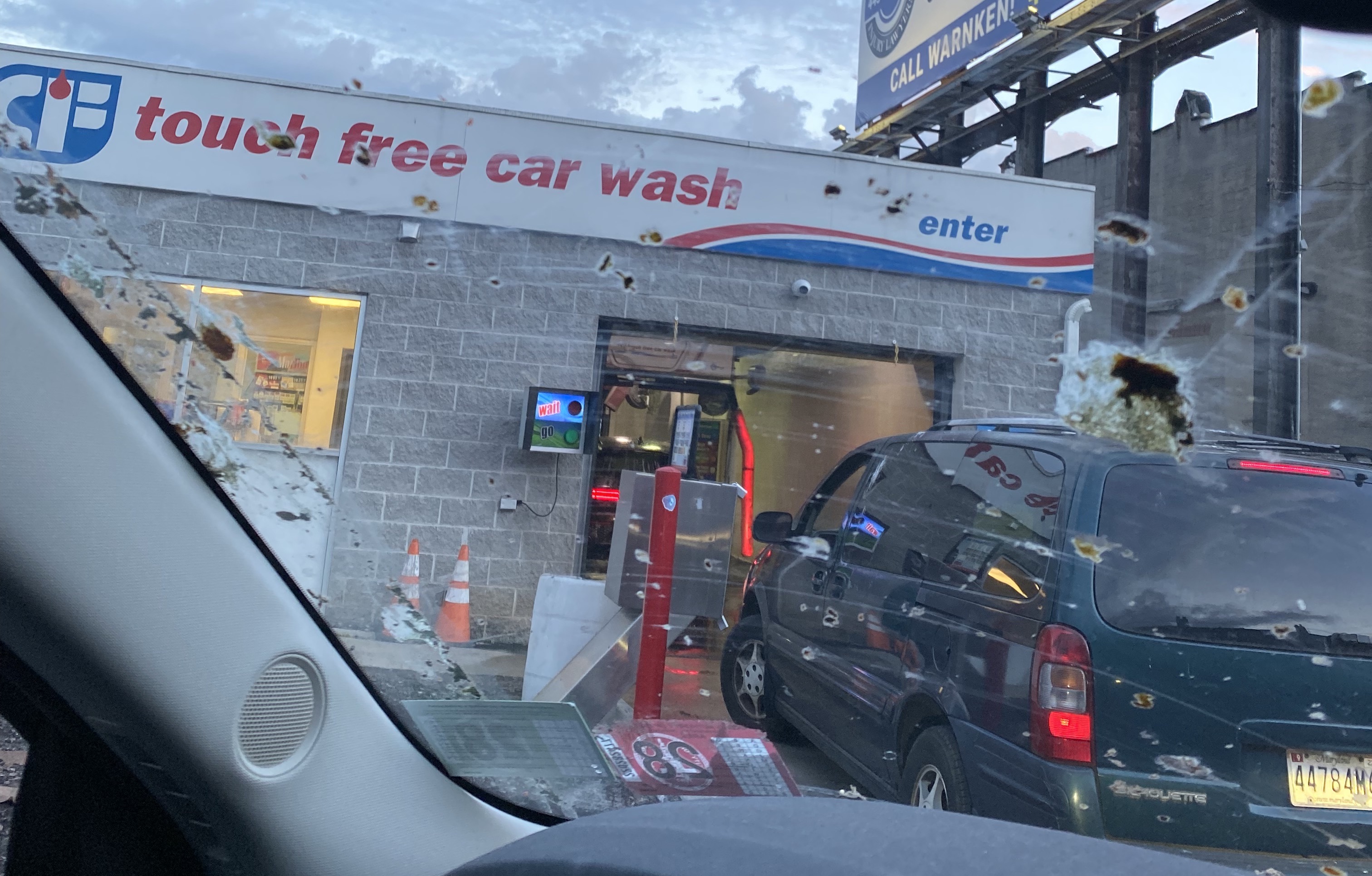What To Do When 500-1,000 Crows Roost In Your Neighborhood
16:01 minutes
 Laura Young was at a breaking point when she submitted a post titled “Request: Make 500-1,000 crows leave my street alone” to the subreddit r/lifeprotips in January. “I think you can tell that I was feeling very frustrated and running out of options and I clearly needed help,” she said.
Laura Young was at a breaking point when she submitted a post titled “Request: Make 500-1,000 crows leave my street alone” to the subreddit r/lifeprotips in January. “I think you can tell that I was feeling very frustrated and running out of options and I clearly needed help,” she said.
Starting last October, Laura’s neighborhood in Baltimore was the site of a massive crow roost. And unlike past years’ roosts, which usually only last a few weeks with a few dozen crows, this one showed no signs of leaving. “The numbers that they’ve attracted ever since then are unbelievable,” she said. “I mean, we’re at the point where it is frightening to walk out at night.”
According to Laura, hundreds of them filled the trees in the park outside her apartment. “And they’re all screaming,” she said. “It is loud enough to wake you up indoors with all the windows closed. I don’t think anyone on my block has slept past 6:00am in three months.”
There was the noise, and then there was the poop: coating the streets, the buildings, and the cars. “It is just disgusting. I’ve never spent so much money on car washes in my entire life,” she laughed.



Laura works in marketing, but she got her degree in wildlife conservation and worked with birds across the U.S. for five years. But even she was at a loss about what to do. She tried scaring them off with a laser pointer—one of her neighbors busted out a vuvuzela to do the same—but nothing made them budge.
So she turned to Reddit to see if anyone there had ideas, but that avenue was mostly fruitless. Someone suggested playing the sounds of owls, a natural predator of crows, to convince them to change roosting spots. Laura rigged up a speaker in her window to play them, but that didn’t work either.
After SciFri producer D. Peterschmidt heard about Laura’s situation, they got her in touch with Kaeli Swift, a postdoctoral researcher at the University of Washington, who has a speciality in crows. They talk about why these roosts happen, the deadly history of crow exterminations, how other cities have ethically addressed large roosts, and how human-wildlife conflicts don’t always have easy solutions.
Do you have experience with large crows roosts? We want to hear about them. If you have stories, audio recordings, pictures, or video, send them to scifri@sciencefriday.com.
Laura Young is the Director of Content Marketing at DealMaker, a capital raise technology startup. Previously, she was a wildlife biologist working primarily with endangered birds.
Kaeli Swift is a postdoctoral researcher at the University of Washington in Seattle.
IRA FLATOW: This is Science Friday. I’m Ira Flatow.
Does your neighborhood get a local crow roost every fall? You know what I’m talking about. Large numbers of crows congregating together during the cold months, usually accompanied by a cacophony of caws, caws, around dusk and dawn. It’s a pretty common sight across the country. I know you’ve seen it.
But there was one extraordinary case that took place in a Baltimore neighborhood this winter, where a massive crow roost took up residence for months. When SciFri producer D Peterschmidt heard about this, they got in touch with someone who tried to do something about it. Here’s D with the rest of the story.
D PETERSCHMIDT: Laura Young is used to crows roosting in her neighborhood in Baltimore every fall. Usually, she sees a few dozen of them perched on the trees in the park outside her apartment. And then, after a couple of weeks, they move on to a new roosting site. But it was a little different this past October.
LAURA YOUNG: It’s insane. I mean, the numbers that they’ve attracted ever since then are unbelievable. I mean, we’re at the point where it is frightening to walk out at night.
D PETERSCHMIDT: Instead of a flock of just a few dozen crows, many, many more quickly amassed. And to Laura initially, it was kind of cool. Halloween, the spooky season, crows, all part of the fun.
LAURA YOUNG: And then they just didn’t leave. It’s like hundreds of them on every twig of every branch of every tree. And they’re all screaming.
[CROWS CAWING]
D PETERSCHMIDT: That was a recording of them that Laura sent me.
LAURA YOUNG: It is loud enough to wake you up indoors with all the windows closed. I don’t think anyone on my block has slept past 6:00 AM in three months.
D PETERSCHMIDT: Wow.
LAURA YOUNG: They’ll kind of dive bomb you. I don’t go outside without a raincoat on anymore. Because the other sound that you can audibly hear at all times outside is just poop hitting the ground and hitting cars and hitting every surface exposed to the world. It is really horrifying.
D PETERSCHMIDT: So Laura works in marketing, but she actually knows quite a bit about birds. She got her degree in wildlife conservation. And she spent five years doing field research with birds throughout the US.
LAURA YOUNG: And then we kind of had a paradigm shift as far as funding goes when Trump was elected. So I think it was a moment when a lot of ecologists did a major career pivot. I was one of them. So I ended up getting a job in marketing, and I’ve been there since. But my background originally is in bird biology.
D PETERSCHMIDT: We first talked in January, and the roost was still going strong. Laura estimated that close to 1,000 crows took up residence. And she says–
LAURA YOUNG: Crows are freakishly intelligent. They almost have the same intelligence level as a human toddler. And the few things that I did definitely know just from the outset were, one, no matter what, when you’re trying to get rid of the birds, you don’t let them see your face. Because they can recognize you with faces. They will decide they don’t like you. And they will tell all their friends to hate you too.
So we’re not just like up against some regular old bird that isn’t strategizing too. It sounds insane, but it’s actually true.
D PETERSCHMIDT: A common suggestion to disperse large roosts is to tie something shiny up in a tree. But these trees are way too tall for Laura to reach. She also tried scaring them with a laser pointer. Which did freak them out a bit. But they would just come back as soon as she stopped.
So she’s joined forces with her neighbors. They all started a group chat and talked strategy. But some of them are reaching a breaking point.
LAURA YOUNG: There’s this really cute family. It’s two parents and two kids. And they walk around holding hands while the kids just scream at the birds. They just screech at them. It’s hysterical. And then at 7:30, there’s this guy who comes out of his place and he blows a vuvuzela at them.
[VUVUZELA SOUNDS]
D PETERSCHMIDT: So that’s not the Horn of Gondor. That’s an actual recording Vuvuzela Guy that Laura sent me. And like the laser pointer, it hasn’t really worked.
LAURA YOUNG: So we’re kind of like this ragtag team of poor unfortunate souls trying to fix this problem. And no one knows how. So anytime I need to know how to do something, I feel like I just go to Reddit. I figured there have to be people out there who have successfully defeated the flock of crows.
D PETERSCHMIDT: Laura turned to the subreddit Life Pro Tips, which offers and receives requests for life advice. She named her post– Request, make 500 to 1,000 crows leave my street alone. And close to 400 people responded.
The best suggestion, according to Laura, was to play the sounds of crows’ natural predators. So she rigged up a speaker in her window to play owl noises. But it didn’t really work. Timing is very critical, it turns out.
LAURA YOUNG: Apparently, once it’s dark out, it’s not in their best interest to leave the entire roosting site and find somewhere else to sleep. So pretty much, I need to communicate to Vuvuzela Guy that he’s doing this way too late at night. Because all he’s doing is scaring the crap out of them– like, literally, out of them– and onto our cars.
D PETERSCHMIDT: Well, I’m wondering if you can read the last paragraph from that post.
LAURA YOUNG: Sure, I can do that. So the last paragraph says– We are going insane as a community. I can’t even believe I’m writing this post. I used to do bird research for a living too. So all my neighbors expect me to somehow know how to evict 1,000 angry flying poop rockets, as if that was part of my college curriculum. Why am I in charge?
[LAUGHTER]
Yeah, I think you can tell that I was feeling very frustrated and running out of options, and I clearly needed help.
[LAUGHTER]
D PETERSCHMIDT: Well, we’re going to try to get you some. That’s what we do here at Science Friday, apparently.
[LAUGHTER]
So when I heard about Laura’s situation, I knew I wanted to get Kaeli Swift’s take. Kaeli is a postdoctoral researcher at the University of Washington, with a specialty in crows. Laura and I wanted to learn more about these roosts, get a sense of how unusual Laura’s case was, and if there was anything Laura and her neighbors could do.
A month later, we all got on the phone.
KAELI SWIFT: Hi, Laura.
LAURA YOUNG: Hey, Kaeli. It’s good to meet you. I’ve heard a lot about you.
KAELI SWIFT: Yeah. You, too. You, too. It’s always fun to meet fellow bird people.
D PETERSCHMIDT: Laura brought Kaeli up to speed, and Kaeli started offering suggestions.
KAELI SWIFT: So for many years, and particularly across European cultures, we’ve had this real negative association with black birds, including crows and ravens. And then, particularly when they gather in large numbers, sometimes seeing that strikes people as ominous or out of the ordinary. And it’s just not. This is a really normal part of their behavior.
D PETERSCHMIDT: Crows have also adapted extraordinarily well to human-dominated landscapes, as opposed to other birds. There’s a few reasons why that is. They might have a decent food source. More concrete means more heat is retained, and they can stay warmer at night than in a forest. There is also usually more light from street lamps, which provides better safety from predators.
So crows roosting in urban areas, it’s not uncommon at all.
KAELI SWIFT: Where it becomes a problem, though, as we’re seeing is that, when you get a really large group of what’s arguably like a fairly big bird together, they do make noise and they do poop. The amount of feces is very real. And so while we need to be careful to not villainize these birds for just doing their totally normal bird thing, I think it’s really important for people who love animals and love crows to extend empathy to folks living in these communities that are just covered in bird crap. Because no one would want to live with that.
So as far as what to do, the unfortunate short answer is that you as an individual civilian are not going to be able to evict this crow roost.
D PETERSCHMIDT: Kaeli specifically says “individual civilian” here because crows are federally protected by the Migratory Bird Treaty Act. And they’re on that list partially because of the particularly bloody history of crow terminations in the US. One of the most extreme examples of this took place in 1940, when the city of Rockford, Illinois, used dynamite to kill a roost of 328,000 crows.
KAELI SWIFT: And so it’s good now. We don’t do that anymore.
D PETERSCHMIDT: Now, local government has to officially intervene with non-lethal approaches when dealing with a large roost. The cities have taken different approaches to dealing with large roosts over the years. In the 2010s, Portland, Oregon was the home of a roost that was about 10 times the size of Laura’s.
KAELI SWIFT: Portland actually did two things. They invested in what was called the Poopmaster 6000.
[LAUGHTER]
Which was great–
[LAUGHTER]
LAURA YOUNG: What?
KAELI SWIFT: Yes, this is a real thing. This was a real thing. The Poopmaster 6000 is basically a Zamboni for sidewalks that cleans up poop.
LAURA YOUNG: Wow.
KAELI SWIFT: Obviously, that doesn’t do much for your cars, but it was an effective way to just keep the sidewalks cleaner. But the best thing you can do is hire a falconer and do hazing. If you can get an actual raptor to just go around and scare them, harass them, and basically show them that this spot that they’ve picked isn’t safe, that’s really the best thing you can do. And a falconer is going to be able to execute that hazing strategy in the most ethical way possible.
D PETERSCHMIDT: But Kaeli had a pretty big caveat here.
KAELI SWIFT: These birds are going to go somewhere. And one of the sources of conflict when it comes to roost management that I don’t hear cities talking about enough when they do embark on hazing strategies is considering, where are these birds going to go, and is what we’re doing just pushing them from a wealthy community that has resources to do this into a poorer community that doesn’t?
And so it’s really important to be thoughtful and sensitive about that. And really, the long-term solution to this is cities should take this into consideration and create green spaces, where these birds can roost without coming into conflict with people. Because they are going to roost somewhere. And that’s obviously not a helpful thing for Laura in this moment. But it is something that I wish cities thought more about. Because we could live in a situation where we just didn’t have this conflict nearly as often.
D PETERSCHMIDT: Hmm. Laura, what do you make of all that?
LAURA YOUNG: Oh, yeah, I have so many thoughts. They, eventually– I’m not sure why– they decided two or three days ago to move five or six blocks away. But they did. And that means that my car is safe now. But my friends who live a few blocks away are now dealing with crow-mageddon. And they were the ones laughing at me just a few weeks ago.
But one of the things about my situation is, being in downtown Baltimore, the wealth of the community really varies from block to block. So it almost feels like a roll of the dice about where they go next could be anything on that spectrum.
D PETERSCHMIDT: Laura was also wondering why so many more crows stayed for so much longer this winter. Kaeli said that’s something that people who study crows don’t really know the answer to either. But no matter the cause, Kaeli still recommended that Laura coordinate with the city about hiring a falconer.
KAELI SWIFT: I wish I had a magic wand that’s like, oh, if you just do this, you can just take all of the crows that are causing problems and put them in this perfect place where they can live in harmony. But that’s just not a thing. Unfortunately, at the end of the day, sometimes there are just human-wildlife conflicts that don’t have easy or fast resolutions.
D PETERSCHMIDT: We had this conversation in February, which meant that Laura had another option– just wait until spring, when the crows would probably naturally leave for their mating season anyway.
KAELI SWIFT: And then this problem could disappear completely or change in a more tolerable way. And so time can be a good solution to this.
D PETERSCHMIDT: Oh, yeah. OK, then. We’ll keep in touch. And I don’t know– best of luck that it resolves ideally for both parties here.
KAELI SWIFT: Yeah.
LAURA YOUNG: Thank you. Yeah.
KAELI SWIFT: All right. You two enjoy the rest of your day.
D PETERSCHMIDT: You’re listening to Science Friday, from WNYC Studios.
The next time I checked in with Laura was a month later, in March, soon after the first day of spring. Were the crows still there, or did Laura find a falconer?
LAURA YOUNG: Yeah. So I wasn’t exactly sure how to get that process started.
D PETERSCHMIDT: Laura was able to find someone in Baltimore City government, and explained her situation to them. He was a little confused at first. But he said, if she priced it out, he could get the right person to look at it.
LAURA YOUNG: And then, magically, I think two or three days later, the crows just disappeared. I almost didn’t notice at first. But I got a text from someone who lived next door. And they said, am I going crazy or have you not heard the flock the last two nights? And I was just like, oh, my gosh. Now that you say that, I feel like it has been less scary here.
[LAUGHTER]
And they really have not come back. So I think we just ran the clock out with them. But I still want to price out some falconers in case they come back. So that gives us six months to scheme what we’re going to do about it.
D PETERSCHMIDT: Right. It’s like, yeah, they heard that you were hiring a falconer, and they were like, oh, time to go.
LAURA YOUNG: I know. I know. I mean, I should have just priced out a falconer earlier. They probably would know somehow.
D PETERSCHMIDT: Like, oh, she’s doing the numbers.
LAURA YOUNG: I mean, they were right outside my window. They were probably watching me on the computer googling, how to hire a falconer to scare crows.
[LAUGHTER]
D PETERSCHMIDT: So in the end, this whole ordeal lasted about five months. Laura is still curious about why the local population exploded this past winter. And she’s going to keep her eyes on the trees when October comes back around this year to see if things will change.
LAURA YOUNG: And you know what. I think after this year, first of all, everyone in the neighborhood really came together. We have a lot of just extra communication between everyone. You’d run into people on the street, and they would all want to talk about the crows, and what are the crows doing? And I feel like we’ve almost banded together.
If it happens again this fall, I feel like I know I have support in all my crazy plans to fix the problem. And it’s kind of been fun, now that it’s in retrospect, I will say.
D PETERSCHMIDT: Yeah. It’s like the real treasure was the friends and neighbors you made all along the way, literally.
[LAUGHTER]
LAURA YOUNG: Right. I know. It’s wild. But I think we’re better prepared this time. And I think, if they start coming back next year, I’m going to invest in a car cover.
[LAUGHTER]
D PETERSCHMIDT: There we go. Cool. Well, thanks for taking us along this journey with you, Laura. And yeah, we’ll circle back in the fall.
[LAUGHTER]
LAURA YOUNG: OK, great. Looking forward to it.
D PETERSCHMIDT: I feel like we need a crow pun to end this off somehow.
LAURA YOUNG: Oh, gosh. Like, you’ll be caw-ling me.
[LAUGHTER]
D PETERSCHMIDT: Yeah. OK, I’ll take that.
LAURA YOUNG: Oh, it was so bad. Oh, gosh.
D PETERSCHMIDT: No, no, no. It counts. It counts. That’s good.
[LAUGHTER]
LAURA YOUNG: I’m glad it worked out.
D PETERSCHMIDT: If you want to see some of the photos and video Laura took of the massive crow roost, including her feces-covered car, head to sciencefriday.com/crows.
For Science Friday. I’m D Peterschmidt.
IRA FLATOW: See, Alfred Hitchcock, these birds are not as scary as you’d like us to think.
And hey, we’d like to learn about your experiences with large crow roosts. So if you have stories, audio recordings, pictures, your own neighborhood’s version of Vuvuzela Guy, let us know. Send them all to SciFri@sciencefriday.com. That’s SciFri@sciencefriday.com.
Copyright © 2023 Science Friday Initiative. All rights reserved. Science Friday transcripts are produced on a tight deadline by 3Play Media. Fidelity to the original aired/published audio or video file might vary, and text might be updated or amended in the future. For the authoritative record of Science Friday’s programming, please visit the original aired/published recording. For terms of use and more information, visit our policies pages at http://www.sciencefriday.com/about/policies/.
Dee Peterschmidt is a producer, host of the podcast Universe of Art, and composes music for Science Friday’s podcasts. Their D&D character is a clumsy bard named Chip Chap Chopman.